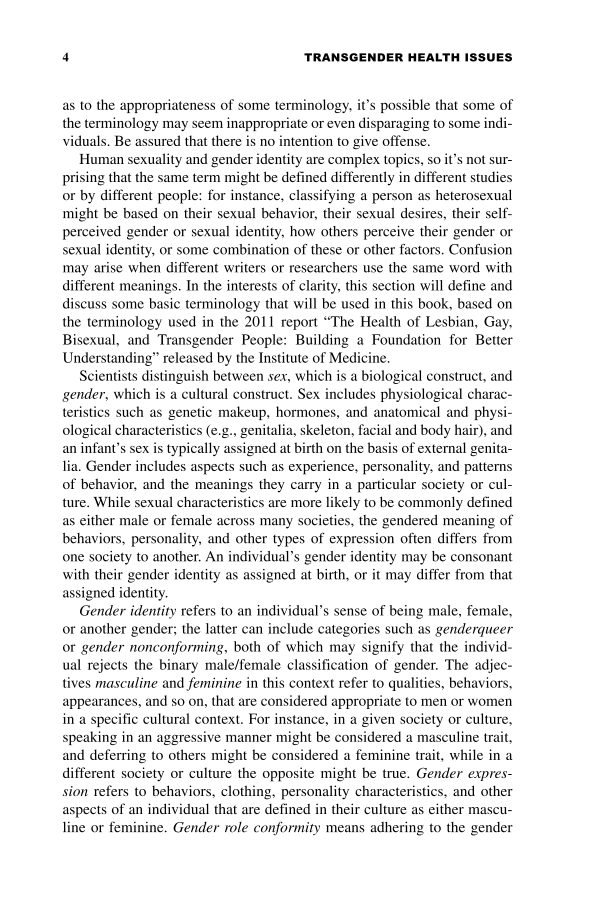4 TRANSGENDER HEALTH ISSUES as to the appropriateness of some terminology, itÊs possible that some of the terminology may seem inappropriate or even disparaging to some indi- viduals. Be assured that there is no intention to give offense. Human sexuality and gender identity are complex topics, so itÊs not sur- prising that the same term might be defined differently in different studies or by different people: for instance, classifying a person as heterosexual might be based on their sexual behavior, their sexual desires, their self- perceived gender or sexual identity, how others perceive their gender or sexual identity, or some combination of these or other factors. Confusion may arise when different writers or researchers use the same word with different meanings. In the interests of clarity, this section will define and discuss some basic terminology that will be used in this book, based on the terminology used in the 2011 report „The Health of Lesbian, Gay, Bisexual, and Transgender People: Building a Foundation for Better Understanding‰ released by the Institute of Medicine. Scientists distinguish between sex , which is a biological construct, and gender , which is a cultural construct. Sex includes physiological charac- teristics such as genetic makeup, hormones, and anatomical and physi- ological characteristics (e.g., genitalia, skeleton, facial and body hair), and an infantÊs sex is typically assigned at birth on the basis of external genita- lia. Gender includes aspects such as experience, personality, and patterns of behavior, and the meanings they carry in a particular society or cul- ture. While sexual characteristics are more likely to be commonly defined as either male or female across many societies, the gendered meaning of behaviors, personality, and other types of expression often differs from one society to another. An individualÊs gender identity may be consonant with their gender identity as assigned at birth, or it may differ from that assigned identity. Gender identity refers to an individualÊs sense of being male, female, or another gender the latter can include categories such as genderqueer or gender nonconforming , both of which may signify that the individ- ual rejects the binary male/female classification of gender. The adjec- tives masculine and feminine in this context refer to qualities, behaviors, appearances, and so on, that are considered appropriate to men or women in a specific cultural context. For instance, in a given society or culture, speaking in an aggressive manner might be considered a masculine trait, and deferring to others might be considered a feminine trait, while in a different society or culture the opposite might be true. Gender expres- sion refers to behaviors, clothing, personality characteristics, and other aspects of an individual that are defined in their culture as either mascu- line or feminine. Gender role conformity means adhering to the gender
Document Details My Account Print multiple pages
Print
You have printed 0 times in the last 24 hours.
Your print count will reset on at .
You may print 0 more time(s) before then.
You may print a maximum of 0 pages at a time.
























































































































































































































